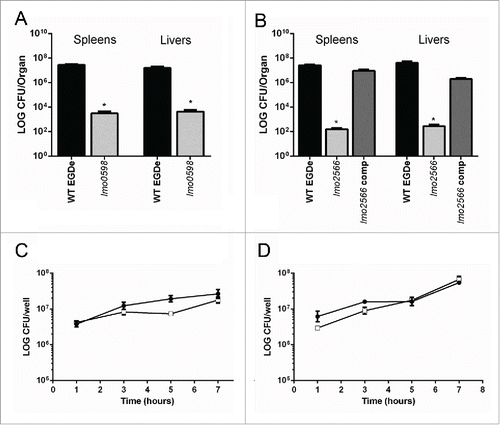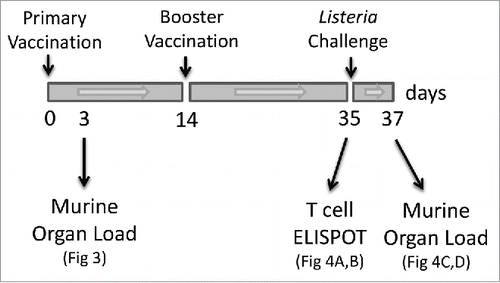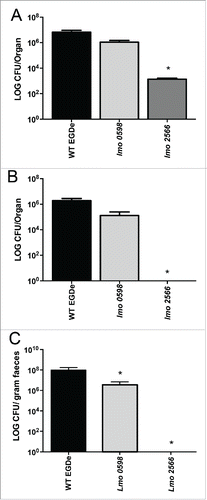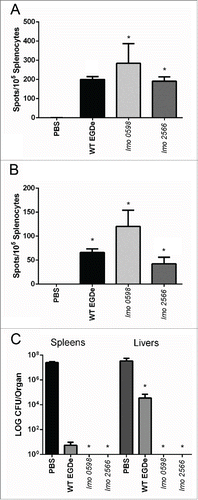Figures & data
Figure 1. Listeriamutants are attenuated for infection of mice but retain an ability to replicate in macrophages. Listeria monocytogenes CFU from livers and spleens of infected mice 3 d post i.p. infection with 3 × 105 CFU. (A) Wild-type (EGDe) and biotin auxotroph Tnlmo0598 levels in livers and spleens. (B) Wild-type (EGDe), Tnlmo2566 and genetically complemented strain (lmo2566 Comp) in livers and spleens. *P < 0.05 by the Kruskal Wallis one way ANOVA, with post hoc comparison using Dunn's method. Differences are shown relative to the wild-type. Error bars represent the mean ± SEM (C) Intracellular growth of wild-type (•) and Tnlmo0598 (□) in J774 macrophage cells using a gentamicin protection assay. (D) Intracellular growth of wild-type (•) and Tnlmo2566 (□) in J774 macrophage cells using a gentamicin protection assay. No statistical significance observed.

Figure 2. Overview of the vaccination study. Balb/c mice received an initial primary vaccination via the i.p. route with live wild-type bacteria (3 × 104 CFU) or attenuated vaccine strains (Tnlmo0598 or Tnlmo2566) (1 × 106 CFU) at time 0. Mice received a vaccination booster on day 14 with the same vaccination doses. Sham inoculated control mice received sterile PBS. A subgroup of mice received a challenge dose of wild type (EGDe) bacteria at day 35. Subgroups of mice were analyzed at day 3 to determine the organ load of the initial vaccination dose and at day 35 for efficacy in generating T cells (by ELISPOT). Protection from secondary infection by L. monocytogenes was determined on day 37 in mice challenged with wild-type bacteria.

Figure 3. L. monocytogenes vaccine strains fail to significantly colonise mouse gallbladders and show reduced faecal excretion. Mice were inoculated via the i.p. route with wild-type (strain EGDe) bacteria (at 3 × 104 CFU) or attenuated vaccine strains (Tnlmo0598 or Tnlmo2566) (1 × 106 CFU) and levels in internal organs were assessed 3 d later. (A) Levels of wild-type (strain EGDe) or attenuated strains Tnlmo0598 or Tnlmo2566 in spleens of infected mice. (B) Levels of wild-type (strain EGDe) or attenuated strains Tnlmo0598 or Tnlmo2566 in gallbladders of infected mice. (C) Levels of wild-type (strain EGDe) or attenuated strains Tnlmo0598 or Tnlmo2566 in faeces of infected mice. *P < 0.05 by the Kruskal Wallis one way ANOVA, with post hoc comparison using Dunn's method. Differences are shown relative to the wild-type. Significant differences are indicated relative to the wild-type. Error bars represent the mean ± SEM.

Figure 4. L. monocytogenes vaccine strains stimulate anti-Listeria T cells and protect mice against secondary infection. Mouse groups were vaccinated as outlined with a primary inoculation on day 0 and a booster at day 14. At day 35 mice were examined for T-cells responsive to (A) LLO91–99 or (B) P60217–225 using peptide pulsed P815-1-1 cells. *P < 0.05 by the Kruskal Wallis one way ANOVA, with post hoc comparison using Dunn's method. Significant differences are shown relative to the sham (PBS) inoculated animals. No significant differences were evident between Tnlmo0598 or Tnlmo2566 vaccinated animals. Error bars represent the mean ± SEM (C) A subgroup of vaccinated mice were challenged with L. monocytogenes wild type (EGDe) (3 × 105 CFU via the i.p. route). Mice vaccinated with wild-type (strain EGDe), attenuated strains Tnlmo0598 or Tnlmo2566 or sham-inoculated mice were analyzed for organ load 2 d post-infection. *P < 0.05 by the Kruskal Wallis one way ANOVA, with post hoc comparison using Dunn's method. Significant differences are shown for protection relative to the sham (PBS) inoculated animals. Error bars represent the mean ± SEM.

